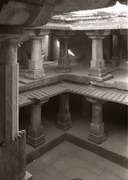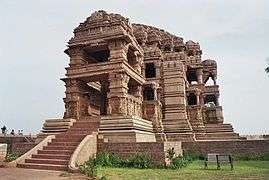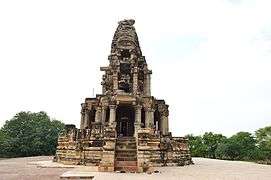Kachchhapaghata dynasty

The Kachchhapaghatas (IAST: Kacchapaghāta) were an Indian dynasty that ruled between 10th and 12th centuries.[2] Their territory included north-western parts of Central India (present-day Madhya Pradesh).[3]
The Sanskrit word Kachchhapa-ghata (कच्छपघात) literally means "tortoise killer".[4] The Kachchhapaghatas were originally the vassals of the Pratiharas and the Chandelas.[5] After the death of the Chandela king Vidyadhara, the Chandela kingdom was weakened by repeated Muslim (Yamini) invasions. Taking advantage of this situation, the Kachchhapaghatas gave up their allegiance to the Chandelas.[6] They became powerful towards the end of the 10th century CE.[5]
The dynasty patronized Shaivism and Vaishnavism, but were tolerant towards Buddhism and Jainism. Several temples were constructed during their reign in Kadwaha.[2]
- Temples built during Kachchhapaghata reign
-

Matha (monastery), Kadwaha
The dynasty was divided into three branches, which ruled from Gwalior (Gopādrigiri), Dubkunda (Chaṇdobha), and Narwar (Nalapur).[5] The Kachchhapaghatas of Gwalior are noted for their art and architecture.[3] Vajradāmana, described as the tilaka of the dynasty in Gwalior inscriptions dated 1093-94 CE and 1104 CE, was probably the first powerful ruler of the dynasty. He served as a feudatory to the Chandela kings Dhanga and Vidyadhara.[3] Kachchhapaghata ruler Mahipala commissioned the Sas-Bahu Temple at Gwalior. Records of two grants issued by him at Gwalior, dated 1093 CE and 1104 CE, have been found. Several silver and gold coins issued by him have also been discovered.[7] Other temples constructed by the Gwalior branch include the ones located at:
- Kadwaha (Kadmbaguhā) in Ashok Nagar district
- Surawaya
- Mahua
- Terahi (Terambhi) in Shivpuri district
- Sihoniya (Simhapāniyā)
- Padhaoli
- Mitaoli in Morena district
- Kherata in Bhind district
Virasimha (also Virasimharama or Virasimhadeva), a Kachchhapaghata ruler of Nalapura, issued a copper plate grant in 1120-21 CE. This record describes him using the title Maharajadhiraja. Gold coins issued by him have also been discovered.[8]
One theory connects the Kachwaha dynasty of Amber with the Kachchhapaghatas of Gwalior, although the Kachwaha inscriptions claim a different origin.[9]
Rulers
The following is a list of known Kachchhapaghata rulers, with estimate of their reigns:[10]
Simhapaniya (Sihoniya) and Gopadri (Gwalior) branch
- Lakshmana (r. c. 950–975)
- Vajradaman (r. c. 975–1000)
- Mangalaraja (r. c. 1000–1015)
- Kirtiraja (r. c. 1015–1035)
- Muladeva (r. c. 1035–1055)
- Devapala (r. c. 1055–1085)
- Padmapala (r. c. 1085–1090)
- Mahipala (r. c. 1090–1105)
- Ratnapala (r. c. 1105–1130)
- Ajayapala (r. c. 1192–1194)
- Sulakshanapala (r. c. 1196)
Dubkund (Dobha) branch
- Yuvaraja (r. c. 1000)
- Arjuna (r. c. 1015–1035)
- Abhimanyu (r. c. 1035–1045)
- Vijayapala (r. c. 1045–1070)
- Vikramasimha (r. c. 1070–1100)
Nalapura (Narwar) branch
- Gaganasimha (r. c. 1075–1090)
- Sharadasimha (r. c. 1090–1105)
- Virasimha (r. c. 1105–1125)
- Tejaskarana
References
- ↑ Om Prakash Misra 2003, p. 15.
- 1 2 "Exploration Of Kadwaha, District Ashoknagar, Madhya Pradesh (2009-2010)". Bhopal: Archaeological Survey of India (Temple Survey Project). Retrieved 9 May 2016.
- 1 2 3 Rahman Ali (2012). "Art of the Kachchhapaghātas in Central India: An assessment". Journal of History & Social Sciences. 3 (2).
- ↑ Henry Miers Elliot (1869). Memoirs on the History, Folk-Lore, and Distribution of the Races of the North Western Provinces of India. Trübner & co. p. 158.
- 1 2 3 Ahmed Ali 2005, p. 2.
- ↑ Sailendra Nath Sen 1999, p. 311.
- ↑ P. C. Roy 1980, pp. 70-71.
- ↑ P. C. Roy 1980, pp. 71-72.
- ↑ V. S. Bhatnagar 1974, p. 4.
- ↑ Michael D. Willis 1996, p. 14.
Bibliography
- Ahmed Ali (2005). Kachchhapaghāta Art and Architecture. Jaipur: Publication Scheme. ISBN 9788181820143.
- Michael D. Willis (1996). "Architecture in Central India under the Kacchapaghata Rulers". South Asian Studies. 12 (1): 13–32.
- Om Prakash Misra (2003). Archaeological Excavations in Central India: Madhya Pradesh and Chhattisgarh. Mittal Publications. ISBN 978-81-7099-874-7.
- P. C. Roy (1980). The Coinage of Northern India. Abhinav. ISBN 9788170171225.
- Sailendra Nath Sen (1999). Ancient Indian History and Civilization. New Age International. ISBN 9788122411980.
- V. S. Bhatnagar (1974). Life and Times of Sawai Jai Singh, 1688-1743. Impex India.

